Yes, people want speed and convenience. But, what they really want is a personalized experience.
Have you ever gone on a company’s website, and initiated live chat support (with what you thought was a real person) only to have a poorly programmed chatbot talk you in circles?
Unfortunately, I’ve been in both of these situations.
I’m sure most people have been. And, I’m sure we can all agree that’s it’s frustrating…infuriating even.
The world is becoming increasingly digital.
Automation is considered a “feature.” Speed is coveted. Convenience is key.
But, when it comes to customer service, many businesses are so focused on “convenience” that they’re forgetting about truly connecting with their customers.
Personalization Is Where It’s At
Personalized customer conversations is what will turn consumers into repeat customers. We here at LiveHelpNow value personalization above all. (Not to toot our own horn, but perhaps that is why we have been named one of the best live chat software of the year by Digital.com)

Anyway, moving on…
A survey conducted by Segment found that 44% of consumers say they will likely give a company repeat business after receiving a personalized experience.
And the benefits of personalization don’t stop there.
According to a Researchscape International study, the top 5 benefits of personalization include increased visitor engagement (55%), improved customer experience (55%), improved brand perception (39%), increased conversion rates (51%) and increased lead generation and customer acquisition (46%).

Personalized Customer Conversations the Live Chat Experience
In their quest to satisfy the consumer demand for accessibility and immediate results, many companies have chosen to introduce a live support platform on their websites. This platform enables businesses to offer real-time assistance, improving customer satisfaction and overall engagement.
Unfortunately, some businesses have not yet figured out how to make personalized customer conversations in live chat.
In order for live chat to be a truly effective customer service tool, it has to be utilized to deliver what I like to call “The Big 3”:
- Speed
- Convenience
- Personalization
Speed and convenience are relatively easy to achieve if you have a well-trained team behind the keyboards.
But, personalizing the live chat experience requires a few extra steps and consistent effort.
Here are 20 tools and/or strategies that can be used to break down the barriers between live chat support and your customers.
[toc exclude=”Personalization is*|Personalizing the*”]
1. Pre-Chat Surveys
Pre-chat surveys automatically collect basic visitor information prior to the actual chat. Their benefits are threefold.
Pre-chat Surveys:
- Provide identifying customer details
- Ensure accuracy
- Express genuine interest
Live Assist recommends collecting the following information in a pre-chat survey.

Once these details are collected, agents will have obtained a basic customer profile and know the purpose of the inquiry.
Thus, your support staff will be thoroughly prepared as they enter each conversation.
Most importantly, this will minimize delays and avoid confusion.
I’m sure we can all agree that nothing is worse than getting passed from agent-to-agent like a hot potato.
If you pre-identify the query topic, most chat software can be optimized to immediately direct your visitors to the correct department.
This level of preparedness will show that your company cares about why your customers are making contact and that you value their time.
2. Proactive Greetings
Before the end of 2020, 51% of consumers will expect that companies anticipate their needs and make relevant suggestions before they make contact (Salesforce).
By 2020, 51% of consumers will expect that companies anticipate their needs and make relevant suggestions before they make contact. @salesforce #customerexperience #customerservice Share on XBy setting up chat triggers, you can optimize your live chat software to do just that.
Chat triggers are pre-written chat messages that are delivered automatically based upon set visitor behavior conditions.
For example, if a customer is making a repeat visit, you can program the chat window to say “welcome back!” as they re-enter your domain.
Or, maybe during their last browse, your customer was looking at a particular product. You can configure your chat settings, so they are presented with a targeted promo code for a previously viewed item.
According to a 2019 Microsoft survey, 66% of respondents reported having a more favorable view of brands that contact them with proactive customer service.
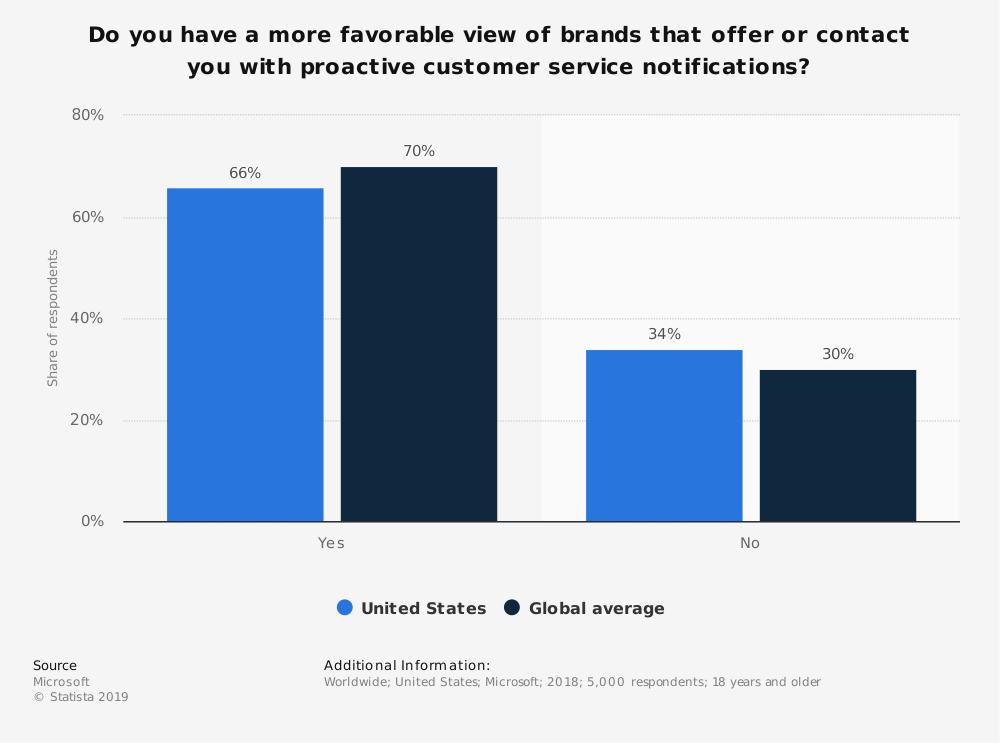
Not only will proactive greetings make your website guests feel welcome, but they will also increase your sales.
An extensive Forrester research study shows that an investment in reactive chat produces a return on investment (ROI) of 15%, while an additional investment in proactive chat capabilities will produce an incremental 105% ROI.
3. Introduce Yourself
I realize I am stating the obvious here, but chat is a conversation. Make it a real one.
Treat each chat as if it’s a face-to-face meeting. Your agents should always start by stating their name and what their position is. Then, ask how they can help.
Research conducted by Rare Consulting has revealed that 83% of consumers say their loyalty is primarily driven by trust.
How can a customer trust you if they don’t know your name and at least a few small details about you?
4. Use a Real Profile Photo
Typically, live chat windows have a space where the operator’s photo appears (as illustrated in LiveHelpNow’s chat window below).
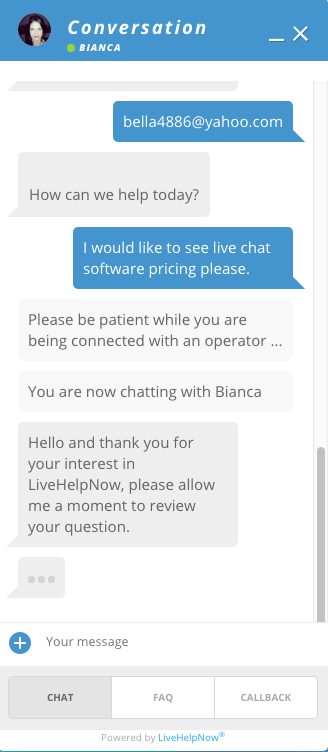
The important thing to remember is that most people can easily identify a fake photo.
Instead of using an avatar or a stock photo, have your team upload real photos of themselves.
Genuine profile photos have a bigger impact than you think. LinkedIn engagement studies validate this point.
Recent statistics show that LinkedIn members with a photo receive far more engagement: 21 times more profile views and 9 times more connection requests.
Humans are visual beings. We’re able to form a stronger emotional connection with online brands when we’re presented with relatable images.
Web Design expert, James George says it best:
“Showing your face will help build recognition for you personally, but it also builds trust with visitors. It’s tough to build trust and authority with a site when you can’t put a face with the name” – James George, “8 Proven Techniques That Build Trust In Your Website”
5. Address Customers Directly
Use the customer’s name.
If you utilize pre-chat forms as I mentioned in tip #1, your agents will know the customer’s name prior to beginning the conversation.
According to a recent report from Accenture, 75% of consumers are more likely to buy from a retailer that recognizes them by name.
Here’s a great article from Qminder, that does a great job of explaining to the true power of personally addressing a customer:
Improve Customer Experience with #Qminder https://t.co/py9sAUexN0
— LiveHelpNow (@LiveHelpNow) May 31, 2019
6. Be Authentic
“Until you understand your customers — deeply and genuinely — you cannot truly serve them.” – Rasheed Ogunlaru, Author of Soul Trader
Be genuinely interested in assisting your customers with their inquiries.
According to a McKinsey study, 70% of the customer’s journey is dictated by how the customer feels they are being treated.
So, ask the right questions. Be thorough. But, know your boundaries.
Don’t be overly friendly. And, don’t be overly formal. Just be real.
7. Limit Automation
Customers still prefer real interactions. So, only use automation when it’s absolutely necessary.
Last year, a NewVoiceMedia study found that 45% of respondents specifically emphasized that chatbots do not provide a truly personalized customer conversations.
Last year, a @NewVoiceMedia study found that 45% of respondents specifically emphasized that chatbots do not provide a truly personal experience. #personalization #CX #customerexperience Share on XAnd, that’s what customers want…a truly personal experience.
In fact, according to a survey conducted by Aspect, 58% of consumers have actually admitted that they feel uncomfortable with non-human customer service interactions.
So, try to use human agents whenever possible. Only use chatbots for off hours or to answer basic questions
8. White-Labeling: Customizable Software
When you select your live chat software, make sure you choose a service that offers white-labeling.
A white-label product is a product or service produced by one company that other companies rebrand to make it appear as if it’s their own.
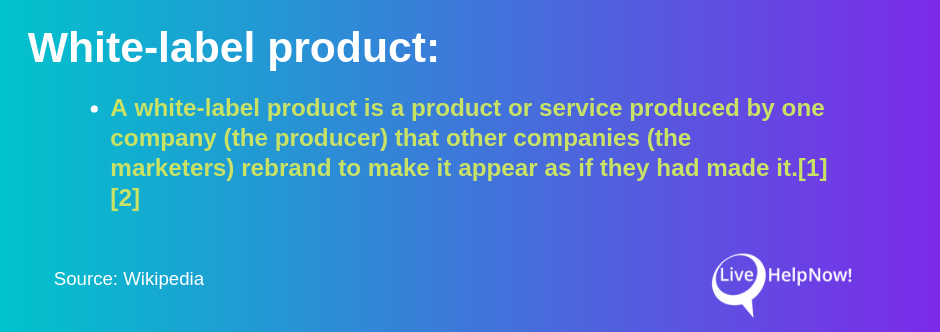
Then, rebrand the software to look like yours by changing the chat window’s colors and logo.
A University of Loyola study found that even an element as minor as color can increase brand recognition by up to 80%.
The last thing you want is for your customers to think that they are speaking with someone from an unrelated chat software company as opposed to someone directly connected to your business.
With a custom-designed chat window, your customers will truly feel that they are speaking with one of your staff members.
According to a recent @lucidpress report, a company’s revenue will increase by 23% on average due to consistent brand representation. #branding #customerservice #CX Share on XTrust me. It pays to ensure that your brand is represented consistently.
According to a recent Lucidpress report, a company’s revenue will increase by 23% on average due to consistent brand representation.
9. Visitor Behavior Maps
Give your agents the gift of visitor behavior maps.
With this tool, they will be able to track customers’ movements prior to the initiated chat.
This Vimeo video from Siteimprove provides a solid overview of how different types of behavior maps work:
Siteimprove Feature Overview: Behavior Map from Siteimprove Inc on Vimeo.
Mapping will highlight the areas of your website that your visitors are most interested in.
For example, your staff will be aware of each customer’s prior website visits, specific pages visited, the length of time spent on each page, etc.
Not sure how to start your mapping journey? Here’s a list of popular mapping software from G2 Crowd.
10. Integrate Live Chat With Your CRM
Customer Relationship Management (CRM) software combines all information from every department throughout the company to provide a holistic view of each customer in real-time.
If you’re not currently using CRM software, this article from My CRM Group will convince you to take the plunge.
Struggling to justify why you need a CRM? 🤔 Read our blog and find out the 5 key benefits of having a CRM. Read it here: https://t.co/zEo81HZ8pk #MSDyn365 pic.twitter.com/0MlhPaKyjZ
— My CRM Group (@MyCRMGroup) July 10, 2018
The key benefits of CRM/Live Chat integration are:
- Consistency: No matter who a visitor speaks with, they will receive a consistent, streamlined experience.
- Personalization: Your agents will have access to a detailed history of each visitor, so they can tailor each conversation to the individual customer’s needs.
- Higher ROI: A Nucleus Research study revealed that companies that use a CRM have an average return on their technology investment of $8.71 for every dollar spent.
By integrating your chat software with your CRM, every detail of your company’s live chat interactions will automatically be recorded for future reference.
Thus, any agent will be able to access a returning customer’s prior complaints, purchase history, pages visited, etc.
When it comes to customer service, it doesn’t get more personal than that.
11. Reference Customers’ Chat Transcript History
Chat transcript history is one of the most valuable tools available to live chat agents.
With the ability to view previous conversations in their entirety, your team can gain a true understanding of customers’ past experiences with your brand.
75% of consumers are more likely to buy from a retailer that recommends options based on past purchases or knows their purchase history (Accenture).
By utilizing live chat transcripts, your agents can dig even deeper.
For example, let’s say that during a female customer’s first contact with your brand, she filled out the pre-chat survey using her proper name (i.e. Susan).
However, during that initial conversation, maybe she casually mentioned she preferred being called “Susie” instead of Susan.
Cultivating details like this can go a long way towards building a more intimate relationship with your website visitors.
Check out this article from TheRodinhoods for more ideas on how to make the most of your live chat transcripts: Are You Making the Most of Your Live Chat Transcripts?
12. Language Translation
Make sure you choose a live chat option that has a built-in translation feature!
A study by the International Customer Management Institute (ICMI) found that 71.5% of customer service managers reported an increase in customer satisfaction scores when they were able to speak with a customer in he or she’s native language. 58.4% said it increased customers’ loyalty to the brand.
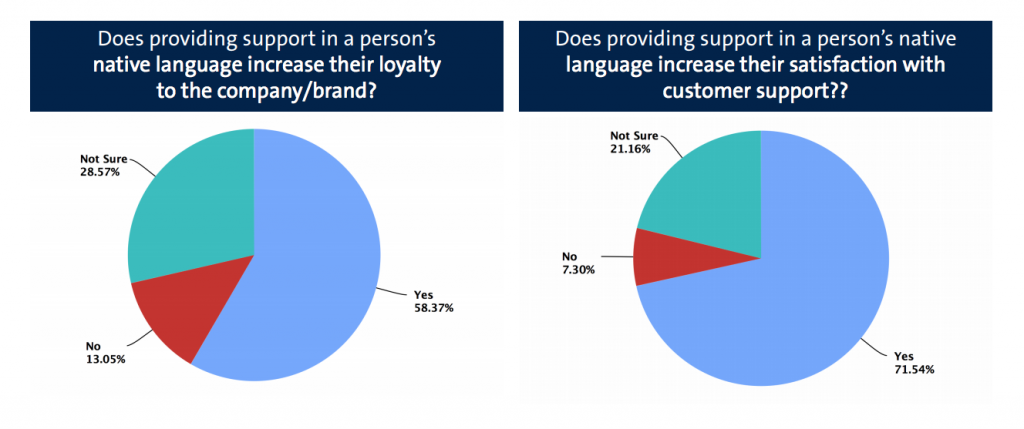
When your agents have the ability to speak with your customers in their native language, it won’t matter where they’re from. Your website visitors will feel at home whenever they chat with you.
This video from Telelanguage highlights a few more reasons you should consider implementing language translation.
13. Stay On Task
We’re all guilty of it. Working behind a computer screen all day can make it easy to get distracted.
In fact, one-third of consumers are disappointed with a brand because of a perceived lack of attention according to Episerver.
One-third of consumers are disappointed with a brand because of a perceived lack of attention according to Episerver. #customerexperience #customersatisfaction #CXjourney @episerver Share on XIt’s not difficult to veer off-track, and become informal or sound disinterested (especially as a live chat agent).
Note: You never want your agents to come off as hypervigilant or stuffy either. It’s all about balance.
The key is to turn customer issues into a “dangling carrot.”
So, offer your top performers an incentive that will keep the entire staff motivated. According to Hawk Incentives, properly structured incentive programs can increase employee performance by as much as 44%.
Even an action as simple as offering recognition can have a huge impact on morale. 77% of employees say they would work harder if they felt better recognized.
Here’s a Quora answer turned Inc.com article with more great tips on how you can keep your team focused.
The 6 Things I Do to Keep My Team Focused @Quora https://t.co/iqSIXZmRFy via @Inc#employeeengagement #employeesatisfaction #customerexperience
— LiveHelpNow (@LiveHelpNow) June 3, 2019
14. Show Appreciation
Always say thank you. No matter what.
Treat every customer inquiry as an opportunity.
For instance, see complaints as a chance to learn. An outside perspective can teach you things about your brand that you would have never realized on your own.
Without consumer feedback, it would be extremely difficult to pinpoint areas for improvement. Additionally, boosting your customer satisfaction scores would be next to impossible.
Secondly, customers LOVE knowing that they’re appreciated. Who doesn’t?
77% of consumers like when brands demonstrate their appreciation (@TDBank_US). #customersatisfaction #customerexperience #customerservice Share on X77% of consumers like when brands demonstrate their appreciation (TD Bank). So, never let them leave a chat without thanking them for their time and their business
15. Know Your Product
Customers want to know that they are in good hands.
If your agents don’t know what they’re talking about, how can a visitor begin to trust your brand?
According to American Express’s Customer Service Barometer study, 62% of customers feel a customer service representative’s knowledge is the most important factor in an interaction.
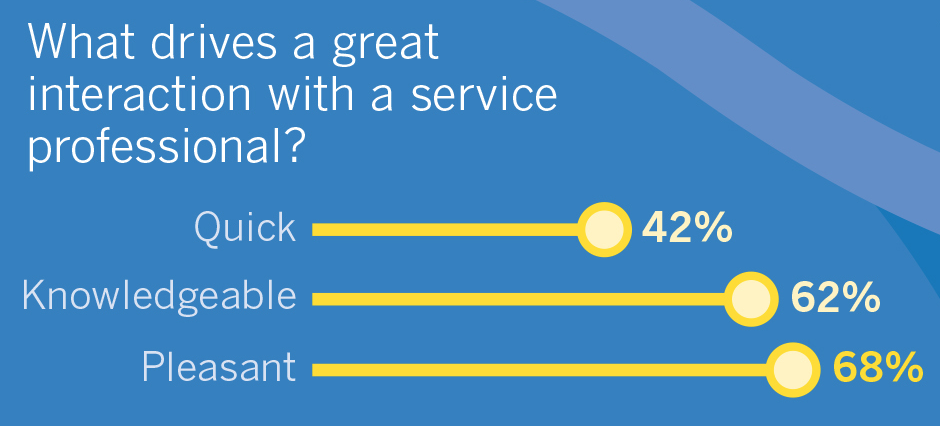
Check out this blog post by business strategist, Meredith Powell, via sales expert, Kenda Lee, for tips on how to increase your staff’s product knowledge.
Great new blog post from @meridithpowell – Five Strategies To Increase Product Knowledge https://t.co/UB291svbx7 #engagement #leadership #sales pic.twitter.com/JretKFabhl
— Kendra Lee (@KendraLeeKLA) April 28, 2018
If a visitor can have confidence in your team’s ability to help, the lane of communication will be a hell of a lot wider and easier to navigate.
16. LISTEN To Your Customers
I’m sure any customer service professional that has been working in the field for an extended period of time feels like they have heard it all.
But, you know what they say about “assuming.”
Live chat agents should never assume that they know where a conversation is headed.
It’s extremely important to let the customer talk.
According to a study conducted by @Apptentive, 55% of consumers say they are not likely to continue buying from a company that ignores their feedback. #customerservice #customerexperience Share on XAccording to a study conducted by Apptentive, 55% of consumers say they are not likely to continue buying from a company that ignores their feedback.
So, a customer should never be cut off or fed what an agent thinks they need to hear.
The most important thing to remember is that the customer’s opinion is worth its weight in gold. As we mentioned in #13, without it, identifying areas for improvement would be extremely difficult.
Keep in mind: 70% of companies that deliver a best in class customer experience use customer feedback to provide a better customer experience (Huffington Post).
17. Keep In Sync With Their Speed
Just like people speak at different speeds, people also chat at different speeds.
So, let the customer take the lead.
According to a study conducted by Forrester, 66% of adults feel that valuing their time is the most important thing a company can do to provide them with good online customer experience.
If a customer receives 5 messages before they have a chance to respond to the first one, they’re going to feel overwhelmed.
In the same respect, if they’re waiting too long for a response, they may think you aren’t paying attention.
18. Use Emojis
It’s important to forge an emotional relationship with your customers, even if it’s from behind a computer screen.
Customers that have an emotional relationship with a brand have a 306% higher lifetime value and will recommend the company at a rate of 71%, rather than the average rate of 45%(Motista).
Unfortunately, facial expressions play a significant role in conveying human emotion.
According to a 2019 psychological study conducted at Kokoro Research Center in Japan, “Facial expressions that indicate emotion are the primary media for human social communication. The appropriate displays of inner emotional states can be useful for adjusting social relationships.”
Obviously, it’s impossible for website visitors to see a live chat agent’s facial expressions.
However, your staff can use emojis as an alternative form of expression!
When apologizing for a mistake, agents can use the 😔 emoji to evoke empathy.
Or, when thanking a customer for their business, agents can use a smiley face 🙂 to show they are genuinely appreciative.
According to the 2016 Emoji Report, 92% of the world’s online population uses emojis. So, you won’t have to worry about your website visitors getting on board.
Emojis are already widely used and recognized.
19. Let Them Text You
It’s safe to assume that most consumers with a cell phone regularly communicate via text message (roughly 65% of the world’s population to be exact – SlickText).
People love to text because it’s convenient. It can be done from anywhere (even from a church pew if your phone is on silent).
But, what if consumers could text your customer support team?
Over half of customers said they would be likely to text with a customer support agent. Similarly, 52 percent would prefer texting customer support over their current preferred form of communication. (eWeek)
52 percent of customers would prefer texting customer support over their current preferred form of communication. @eWEEKNews #customerexperience #textochat #customerservice Share on XThe good news is that many live chat softwares now include a text-to-chat (SMS) feature. So, what are you waiting for? Give the people what they want.
Still need convincing? Check out LiveHelpNow’s recent blog post that will give you 6 Reasons You Should Let Your Customers Text You.
20. Email Customers Their Chat Transcripts
Email customers their final chat transcripts to keep for their records.
A 2009 UK study found that the average adult forgets three key facts, chores or events every day. Therefore, a conversation with chat support shouldn’t be one more thing your customers have to remember.
Unfortunately, chat transcripts are a significantly undervalued resource. 55% of companies do not offer transcripts once a chat has ended. (Super Office).
This presents a huge opportunity for companies to help customers recall information they may need but have forgotten to write down.
According to Harvard Business Review, the #1 most important factor in customer loyalty is the reduction of customer effort (Conversocial).
According to @HarvardBiz, the #1 most important factor in customer loyalty is the reduction of customer effort. via @conversocial #customerexperience #customerloyalty #customerservice Share on XIf your staff provides your website visitors with their chat transcript at the end of every interaction, it could potentially save your customers several steps.
They can refer back to the document to review specific instructions or access helpful links that your team provided.
Your website visitors will never again have to go through the hassle of returning to your support team if they can’t remember key details.
21. BONUS: Always Give A Little Extra
Encourage your staff to go the extra mile for your customers.
A recent Walker Research Report found that customer experience will overtake price and product as the key brand differentiator by 2020.
So, make resolutions as convenient as possible.
For example, have your agents offer to walk customers through the steps they need to take to reset their password or provide helpful informational videos.
Offer discounts or promo codes to repeat visitors as a thank you.
Giving a little extra can go a long way.
Enjoy this recap of “20 Ways to Make the Live Chat Experience More Personal”:
For more business tips and customer service advice like LiveHelpNow on Facebook or follow our business page on LinkedIn.




